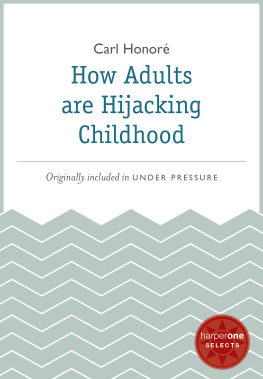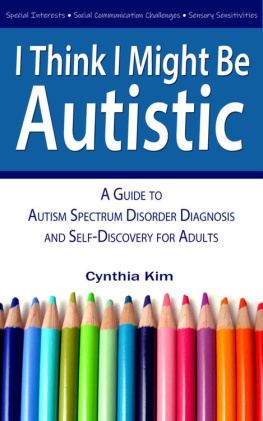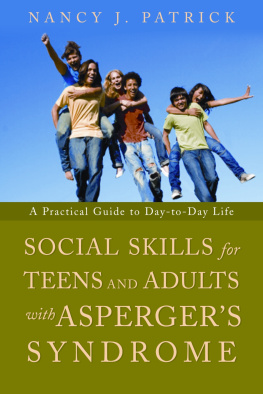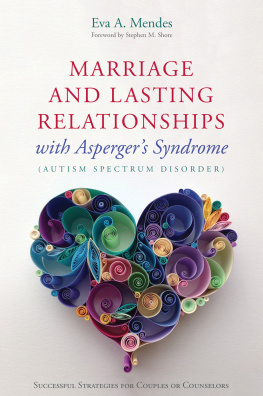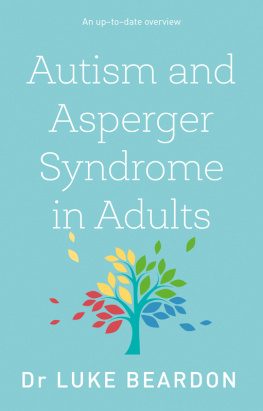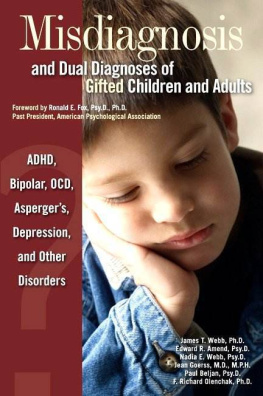Solutions
FOR
Adults
WITH
ASPERGER
SYNDROME
Maximizing the Benefits, Minimizing the Drawbacks to Achieve Success
JUANITA P. LOVETT, PH.D.

To my daughter, Laura, whose help made it happen.
To Terry T., who first named Aspergers syndrome for me.
And to the families who helped me to understand AS.
Contents
PART I: LEARNING ABOUT AS
PART II: LIVING WITH AS
Psychologist Juanita Lovett drew on her years of experience working with adults with Asperger Syndrome (AS) to create a book that clearly and accurately describes AS, its characteristics, and how it presents itself in adulthood. In addition to providing valuable and much needed resources, she uses real-life examples to explain the impact of the diagnosis on adults, their relationships, and those who love and work with them. This book is a welcome and valuable resource, and I will happily recommend it to OASIS visitors.
Barbara Kirby, co-author of The OASIS Guide to Asperger
Syndrome and founder of the OASIS (Online Asperger
Syndrome Information and Support)
Web site at www.aspergersyndrome.org.
Foreword
This book encompasses the once overlooked needs of adults with AS and also the needs of the families who love and care for them. Dr. Jaunita P. Lovett, Ph.D. explains some of the classic AS behaviors that until now have been hidden from medical professionals and other segments of societybehaviors often labeled family secrets and kept behind closed doors by families living with AS.
The American Psychiatric Association did not recognize AS in its Diagnostic and Statistical Manual of Mental Disorders: Fourth Edition, or DSM-IV, until 1994 in the U.S., and then it was only in children. But children have a way of growing into adulthood; and children who have AS will also have the disorder as adults. For some unknown reason, medical professionals in the past ignored this fact and because of their miscalculations adults with AS have been completely ignored.
Adults who have AS are found throughout all segments of societyin every corner of every country in the world.
Society has benefited from individuals suspected of having ASincluding such great minds as Van Gogh, Einstein, and Bach. Of course, because they are no longer living, these talented geniuses cannot be officially diagnosed, but their personal stories are part of history. Geniuses with AS have opened our hearts and our eyes to beautiful art and music and our minds to new frontiers of thought.
Thanks to Dr. Lovetts book and the efforts of many other professionals and nonprofessionals alike, society is becoming more informed about autistic spectrum disorders and, more specifically, AS in adults and how it affects other family members.
More understanding and services are needed for assistance and support for adults with AS and their families. Only then will millions of people be given a chance to realize and cope with the reality that individuals with AS may think and act differently. These individuals are not broken or bad. They dont need to be fixed. They are simply different.
The stigma of autism spectrum disorders will begin to diminish as soon as truthful information is offered to the public regarding these neurological/biological disorders and they are understood and accepted as part of the human condition.
Solutions for Adults with Asperger Syndrome is a book I highly recommend to adults with AS, their families, professionals, educators, and anyone who works with the public. AS is all around us. Your life and your ability to better understand AS could benefit greatly by reading this book.
Ignorance breeds intolerance, and intolerance is unacceptable.
Karen E. Rodman,
Director and Founder, Families of Adults Afflicted with
Aspergers Syndrome (FAAAS), Inc.,http://www.faaas.org
Introduction
For so long, the idea that Asperger Syndrome [AS] occurs in adults has been so taboo that by reading the textbooks on AS, one would be left with the impression that AS is miraculously cured or is uniformly fatal at age 18.
This quote is from a health care professional who has personally experienced the impact of Asperger Syndrome (AS). After having one child diagnosed as autistic and a second diagnosed as having AS, she realized that her husband shared many of the same characteristics, such as problems with communication and difficulties with understanding relationships. These characteristics had caused many problems in their marriage, but her husband refused to be evaluated. This prompted his wife to begin searching for information in the medical literature about AS in adults, hoping to better understand her husband and to improve their relationship. To her frustration, she found little helpful information. Although there was information about AS in children, there was very little research looking at AS in adults to help her understand the syndrome.
Becoming Aware of AS
When I first became aware of AS as a new diagnostic category, I was struck by how well the pattern of symptoms matched characteristics of some individuals that I had seen as patients over my twenty-five years of practice as a clinical psychologist. I had also encountered these characteristics in a number of people I had come across in my organizational effectiveness consulting work for large, high-tech organizations. These patients and employees had never really fit any of the existing diagnostic categories because of their unusual pattern of symptoms and abilities. Many of these people were brilliant, and some were professionally quite successful. But all of them had difficulty with intimate relationships and were uncomfortable dealing with social situations. Some had special interests, often unusual, that preoccupied them, sometimes to the point of dominating their lives. Many had scripts that they routinely used to deal with other people. Their difficulties began when the scripts werent enoughwhen the relationship demanded more than just formalities. In these cases, it quickly became clear that these individuals struggled with understanding interpersonal relationships despite their very high IQs. The suburban location where I practiced contained many exceptionally gifted patients, yet these extremely intelligent people seemed unable to grasp the role they had played in the problems they had with other people. AS as a diagnosis seemed to offer the explanation for their problems. I decided that I needed to learn more about AS, and I began to look for sources of professional education such as professional conferences and publications that would tell me more about this syndrome. At that time, the only available information focused on children. Like the health care professional quoted above, I was frustrated that there was almost no information on AS in adults.
AS Is a Mystifying Syndrome
AS is a syndrome that seems to mystify the people who become involved with it. Many people with AS are very intelligent and often have unusual abilities, such as a remarkable memory for facts or an uncanny ability to solve mathematical calculations. These abilities often coexist with difficulties in communication, an inability to understand other peoples perspectives, problems with social interactions, and a tendency to be obsessed with a special interest in some unusual area (for example, trains and railroad timetables or complex mathematical equations). It is difficult to make sense of this unusual pattern of strengths and weaknesses, and this is what mystifies people. The question that is so compelling is this: How is it possible for someone to be so exceptional in understanding some things and yet seem to have little or no ability to understand other kinds of things, especially ones that involve other people?


